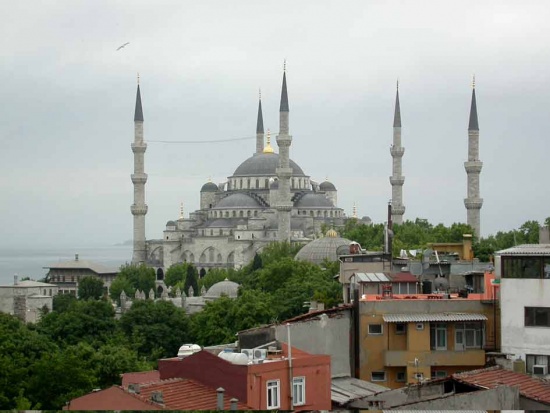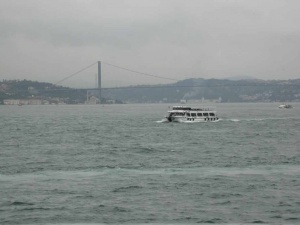| This article is incomplete. This article is missing one or more sections. You can help the BirdForum Opus by expanding it. |
Overview
Straddling the Bosphorus, Istanbul is a city in two continents and a classic migration bottleneck where many thousands of migrant birds from Europe pass into the Middle East.
Birds
Raptors are the main attraction for the many birders that visit Istanbul each year and most European species pass through although some peak at different times. European Honey Buzzard and Common Buzzard, Lesser Spotted Eagle and Levant Sparrowhawk are among the most numerous but more than 20 species have been recorded.
In addition to raptors both storks occur in thousands and many smaller birds such as European Nightjar, Wryneck and European Bee-eater and passerines including chats, warblers and buntings.
Yelkouan Shearwater and Scopoli's Shearwater can be seen on the Bosphorus and in the city of Istanbul Laughing Dove and Black Kite are common as are Alpine Swift and Pallid Swift.
The most popular watchpoints are the hills of Camlica on the Asiatic side of the Bosphorus.
Camlica
Camlica can be reached by taking the southerly suspension bridge across the water and following signs to Camlica. Kucuk Camlica is straight on and Buyuk Camlica to the left, the latter is the most popular watchpoint and there is a conveniently situated cafe on the hill. Camlica is also easily reached by public transport.
Sariyer
On the European side of the Bosphorus the hill of Sariyer, 15km north of the city centre is another excellent migration watchpoint and other wooded hills in the general area are likely to be good for migrants and there are also Syrian Woodpecker and Middle Spotted Woodpecker, Short-toed Treecreeper and Olive-tree Warbler.
Check-list
Birds you can see here include:
Black-throated Diver, Great Crested Grebe, Scopoli's Shearwater, Yelkouan Shearwater, Great Cormorant, Mediterranean Shag, Little Egret, Great White Heron, Purple Heron, Black Stork, White Stork, Greater White-fronted Goose, Northern Shoveler, Common Pochard, Tufted Duck, Smew, European Honey Buzzard, Red Kite, Black Kite, White-tailed Eagle, Egyptian Vulture, Griffon Vulture, Short-toed Eagle, Marsh Harrier, Hen Harrier, Pallid Harrier, Montagu's Harrier, Eurasian Goshawk, Eurasian Sparrowhawk, Levant Sparrowhawk, Common Buzzard, Long-legged Buzzard, Lesser Spotted Eagle, Greater Spotted Eagle, Steppe Eagle, Eastern Imperial Eagle, Bonelli's Eagle, Booted Eagle, Osprey, Lesser Kestrel, Common Kestrel, Red-footed Falcon, Northern Hobby, Lanner Falcon, Saker Falcon, Peregrine Falcon, Eurasian Coot, Common Crane, Mediterranean Gull, Common Tern, Whiskered Tern, White-winged Black Tern, Black Tern, Laughing Dove, Eurasian Scops Owl, European Nightjar, Common Swift, Pallid Swift, Alpine Swift, European Bee-eater, Wryneck, Syrian Woodpecker, Middle Spotted Woodpecker, Red-throated Pipit, Common Redstart, Eastern Olivaceous Warbler, Olive-tree Warbler, Icterine Warbler, Sardinian Warbler, Blackcap, Red-breasted Flycatcher, Semi-collared Flycatcher, Short-toed Treecreeper, Hooded Crow, European Serin, European Goldfinch, Cirl Bunting, Black-headed Bunting
Other Wildlife
To do
Site Information
Areas of Interest
Buyuk Cekmece Golu
Situated on the outskirts of Istanbul and linked to the Sea of Marmara is Buyuk Cekmece Golu another good site for migrants and wintering birds. Although largely surrounded by built-up areas and farmland this lake holds good numbers of grebes and waterfowl, including Smew, and marsh terns and Mediterranean Gull occur in large numbers in autumn.
Rumelifeneri
To the north of Istanbul where the Bosphorus meets the Black Sea is the old fort of Rumelifeneri where seawatching in autumn and winter will produce divers and Mediterranean Shag.
Access and Facilities
Istanbul has plentiful and varied accommodation to suit all tastes and pockets. The best times to visit are undoubtedly spring and autumn and the greatest variety of migrant raptors occurs in September. Storks generally pass through in August and early September. Spring has much the same species but in rather smaller numbers. Mid-morning to mid-afternoon is the peak time for watching migrants.
Contact Details
To do
External Links
Content and images originally posted by Steve





